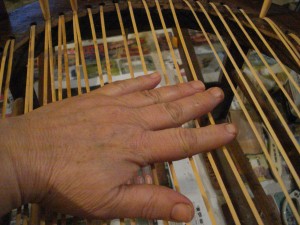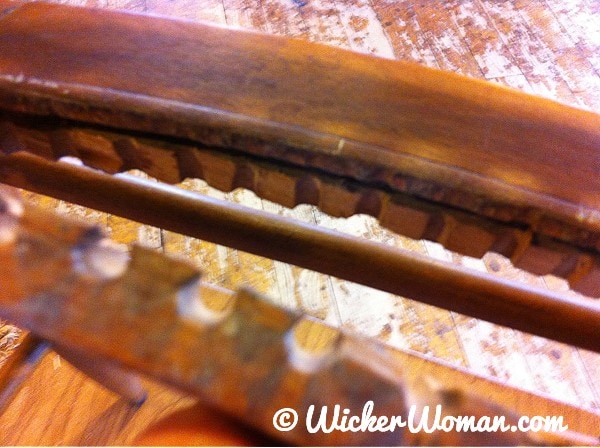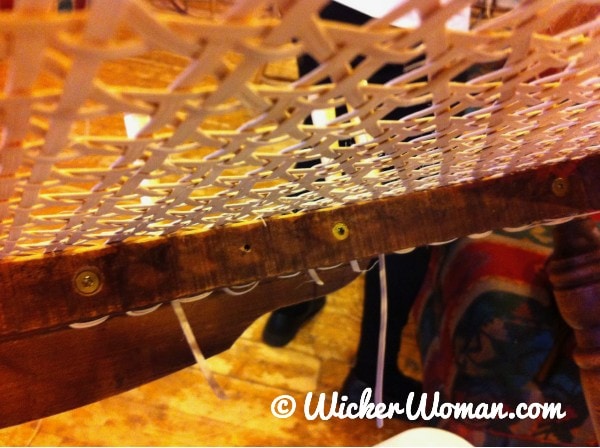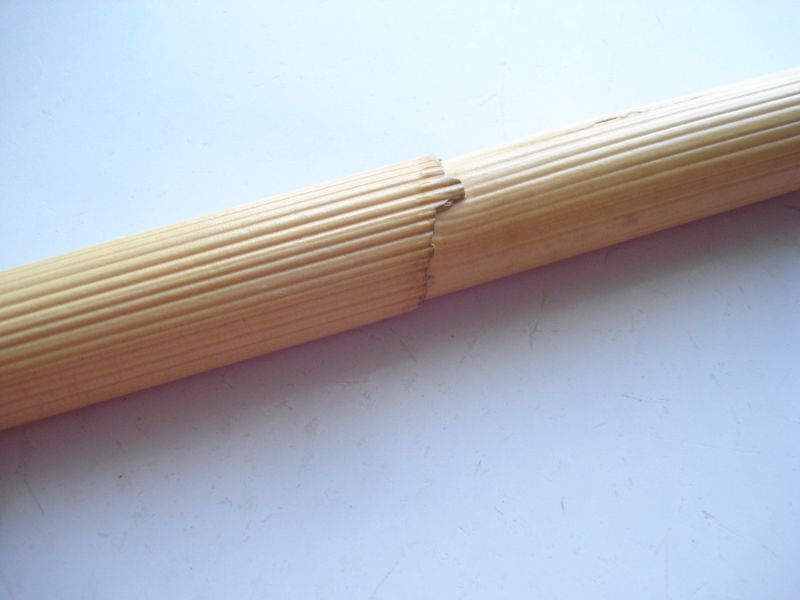TUESDAY TIP OF THE DAY–Today’s blog post is about a situation that new chair caners encounter frequently, and it’s a question I’m asked many times during the chair caning classes I teach.
“How tight is too tight when you are caning a traditional, hole-to-hole, strand cane chair seat?”
I have always set up the first four steps a little on the loose side because as you weave the diagonal steps, #5 and #6, the tension on the previous steps gets tighter.
If you are weaving a hole-to-hole cane seat using a caning needle, then the steps are in a different sequence, so the first two vertical steps are the ones to leave a bit on the loose side. As in the picture below.

And keep in mind that the entire woven cane chair seat tightens as it dries, too.
So a good rule of thumb is to put at least the first two foundation steps (Seven Step Method Pattern) in looser than normal to allow for the change in tension when the actual weaving steps of #4, #5 and #6 are added.
Because if you put the strands in too tight, you run the risk of the cane as it dries, breaking the seat’s framework.

RELATED: Weaving the 7-steps of Hole-to-Hole Caning
The wood will split right down the center of the drilled holes in the seat frame, causing the seat and the chair to fail.
Then the cane seat must be removed, and the chair frame must be screwed and glued back together before you can reweave the seat properly.

But on the other hand, you don’t want to weave the steps in so loose that loops are hanging down underneath the bottom of the seat, either.
So there’s a fine line that comes with experience and following my or your teacher’s expert advice about “how tight is too tight when weaving a hole cane seat?”
Good luck and let me know in the comments what experiences you’ve had with weaving hole-to-hole chair caning, either too tight or too loose.

What are your thoughts about this blog post?
Leave your comments below and share with your social networks!
~~Live Well, Laugh Often, Love Much ~~
Happy Weaving, until next time!





I started redoing a cane chair my grandfather built, however I did steps 1-3 too tight! I got 2 lines on step 4 before I realized that 5&6 are gonna be a beast! before I get further in should I scrap the work I have done and start over?
So sorry to hear you put the first few steps in too tightly, Alura. If you have enough cane to redo the seat, that would probably be the best idea. But you don’t need to take out all the steps. Try taking out the first two and see how that very first row you put in is in fact, too tight. And if it is, then yes, remove that too and start all over again.
I am stuck, and hope you will help me. I turned to chair repair last year when I lost my executive job. I am pleased with my repairs including tightening and upholstey. I have caned 3 chair backs with prewoven cane with a very good outcome. The finish is the problem. They were 20 years old, and stain was wrong and ended up muddy. I have used paint remover and used analine dye with moderate success, it isn’t really even. Even when I dye new cane, it isn’t really nice. Can you suggest anything? Should alcohol be used instead of water base? It seems like the cane has something on it, it stains a piece of wood well. Thanks in advance of your consideration.
So sorry to hear about you losing your job, but taking up the craft of chair seat weaving certainly helps out in a pinch! And there are those of us that do make a pretty good living at it too, so hang in there. As you’ve found out, applying a finish to cane seats or backs is a real problem and not easily done with good final results. Please refer to the questions and answers I give which address that exact problem on the Seatweaving FAQ page of my website and the Article–What are Cane and Reed?. Good luck and hope all this helps!